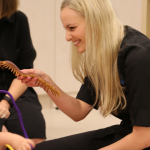Sleep and young children is a contested area. People have different practices and approaches, whether they are families, educational settings or others. In this blog, PAM LINKE explores the importance of sleep for very young children and the different sleep needs of adults and young children. Early Childhood Australia (ECA) has a range of different quality-assured resources on sleep available at the end of this article.

Sleep and sleep practices are fundamental to children’s wellbeing, growth and development (HealthyPeople.gov, n.d.).
Sleep is especially important for infants and young children, and is an essential part of early childhood education and care programs. Providing for adequate sleep and safe sleeping practices with young children is an important role for early childhood educators.
There are two kinds of sleep: deep sleep and lighter sleep called REM (rapid eye movement) sleep. Deep sleep is the time when the body grows and heals, and light sleep is when we dream and ‘work through’ what has happened during the day. Both kinds of sleep are important.
Adults have four-hour sleep cycles. This means that every four hours or so, adults will have a time of lighter sleep when we might stir a bit, or turn over and go back to sleep again. If we have any worries, or are cold or hungry, it can be hard to get back to sleep.
Babies experience more REM sleep than adults do, so they are more likely to awaken. In babies, lighter sleep happens approximately every 45 minutes. This is when they might wake up if everything isn’t feeling just right for them and/or they need a feed or some help to re-settle. By three months of age, babies go into deep sleep more quickly than when they were younger. Toddlers usually take about an hour for each sleep cycle. This gradually changes as they grow older, so that by adolescence, their sleep patterns are more like that of adults’ sleep patterns. Understanding normal patterns of development, and speaking with parents about their child’s sleep cycles at home will assist early childhood educators in supporting healthy sleep patterns in services’ daily programs.
Tips for bedtime difficulties
If parents/carers talk to us about bedtime difficulties, here are some suggestions to pass on to these families to help children feel less lonely in bed:
- Give children time to wind down with quiet play rather than TV and bright lights.
- Provide children with some special one-on-one time with a parent/carer at bedtime, just talking or doing something quiet.
- Keep a bedtime ritual.
- Leave a light on (make sure it is a soft, red light—other colours, especially white or blue, can interfere with sleep hormones).
- Let children have a cuddly toy.
- Play soft music or leave a radio playing at a low volume.
- Leave the door open.
The Australian Children’s Education and Care Quality Authority (ACECQA) has provided policies and guidelines about sleep in early childhood education and care. These are to ensure the meeting of children’s comfort, safety, wellbeing and individual needs (ACECQA, n.d.b). Understanding the importance of sleep in young children’s development and learning, and safe sleep for every child in daily educational programs and practices, is a key responsibility of early childhood educators.
Suggested further reading
- ECA (in partnership with Murdoch Children’s Research Institute) developed a package of modules exploring sleep and safe sleep practices available here.
- Settling multiple children in ECEC settings, an ECA Learning Hub Webinar by sleep expert Cindy Davenport.
- Australian Association for Infant Mental Health: Responding to baby’s cues. Available here.
This article was adapted from the Everyday Learning Series title—Sleep in early childhood. To purchase your copy, click here.











